Don't wanna be here? Send us removal request.
Text
Using SQL for Data Profiling: Analysing Data Quality and Consistency
ExcelR’s data analyst classes is tailored for individuals aiming to excel in data-driven roles. The course covers Excel, SQL, Tableau, Power BI, Python, and data visualization techniques. With expert-led training, real-time projects, and placement assistance, learners gain practical skills to analyze and interpret data effectively. ExcelR’s Data Analyst Course in Pune prepares you for a successful analytics career across various industries with job-oriented, hands-on learning.
0 notes
Text
data science course
Kickstart your analytics journey with ExcelR’s data science course. This program blends theory with real-world applications, covering Python, statistics, machine learning, and data handling tools. Designed for beginners and professionals alike, it offers industry-relevant training, expert mentorship, and career support. With hands-on projects and a strong curriculum, ExcelR equips you with the skills needed to thrive in today’s data-driven world.
Business Name: ExcelR - Data Science, Data Analyst Course Training
Address: 1st Floor, East Court Phoenix Market City, F-02, Clover Park, Viman Nagar, Pune, Maharashtra 411014
Phone Number: 096997 53213Email Id: [email protected]
0 notes
Text
data analysis course in pune
ExcelR’s data analysis course in pune is tailored for individuals aiming to excel in data-driven roles. The course covers Excel, SQL, Tableau, Power BI, Python, and data visualization techniques. With expert-led training, real-time projects, and placement assistance, learners gain practical skills to analyze and interpret data effectively. ExcelR’s Data Analyst Course in Pune prepares you for a successful analytics career across various industries with job-oriented, hands-on learning.
Business Name: ExcelR - Data Science, Data Analytics Course Training in Pune
Address: 101 A ,1st Floor, Siddh Icon, Baner Rd, opposite Lane To Royal Enfield Showroom, beside Asian Box Restaurant, Baner, Pune, Maharashtra 411045
Phone Number: 098809 13504
Email Id: [email protected]
0 notes
Text
data analyst course in pune
ExcelR’s data analyst course in pune is tailored for individuals aiming to excel in data-driven roles. The course covers Excel, SQL, Tableau, Power BI, Python, and data visualization techniques. With expert-led training, real-time projects, and placement assistance, learners gain practical skills to analyze and interpret data effectively. ExcelR’s Data Analyst Course in Pune prepares you for a successful analytics career across various industries with job-oriented, hands-on learning.
Business Name: ExcelR - Data Science, Data Analytics Course Training in Pune
Address: 101 A ,1st Floor, Siddh Icon, Baner Rd, opposite Lane To Royal Enfield Showroom, beside Asian Box Restaurant, Baner, Pune, Maharashtra 411045
Phone Number: 098809 13504
Email Id: [email protected]
0 notes
Text
data analysis course in pune
ExcelR’s data analysis course in pune offers hands-on training in Python, R, Machine Learning, AI, and Data Analytics. Designed for beginners and professionals, it includes real-world projects, expert mentorship, and placement assistance. Gain industry-relevant skills and certifications to advance your career in data science. Enroll now to become a data-driven decision-maker with ExcelR’s comprehensive training.
Business Name: ExcelR - Data Science, Data Analyst Course Training
Address: 1st Floor, East Court Phoenix Market City, F-02, Clover Park, Viman Nagar, Pune, Maharashtra 411014
Phone Number: 096997 53213
Email Id: [email protected]
0 notes
Text
data analytics course
Our career-focused data analytics course helps young graduates build practical skills for real-world applications. With our placement support, you can confidently step into high-demand roles in analytics. Know more by connecting with ExcelR’s career counsellor today.
0 notes
Text
data analysis course in pune
Our career-focused data analysis course in pune helps young graduates build practical skills for real-world applications. With our placement support, you can confidently step into high-demand roles in analytics. Know more by connecting with ExcelR’s career counsellor today.
Business Name: ExcelR - Data Science, Data Analyst Course Training
Address: 1st Floor, East Court Phoenix Market City, F-02, Clover Park, Viman Nagar, Pune, Maharashtra 411014
Phone Number: 096997 53213
Email Id: [email protected]
0 notes
Text
Real-World Data Science Projects for Beginners
Data science is a field where practical experience matters as much as theoretical knowledge. While mastering concepts like machine learning, data visualisation, and data manipulation is essential, applying them to real-world projects is what truly prepares you for a successful career. Beginners often wonder where to start and what projects to focus on. Whether you're learning through a data science or a data scientist course in Pune, working on hands-on projects can significantly enhance your skills and confidence.
This article explores beginner-friendly data science projects, highlighting their importance and how they can fast-track your journey to becoming a proficient data scientist.
Why Real-World Projects Matter
1. Applying Theory to Practice
Working on projects bridges the gap between academic learning and real-world application. It allows you to understand how theoretical concepts are used to solve practical problems.
2. Building a Portfolio
Employers look for proof of your skills. A portfolio showcasing your work on real-world projects can significantly boost your probability of landing a data science job.
3. Developing Problem-Solving Skills
Data science involves tackling messy, unstructured data. Projects help you hone your ability to clean, process, and analyse data effectively.
4. Boosting Confidence
Solving real-world problems gives you the confidence to tackle more complex challenges in professional settings.
Beginner-Friendly Data Science Projects
1. Exploratory Data Analysis (EDA)
EDA is the foundation of any data science project. Start by selecting a dataset from platforms like Kaggle or UCI Machine Learning Repository. Analyse it to uncover patterns, correlations, and insights.
Example: Analyse a dataset of customer purchases to understand trends and seasonality.
Tools: Python libraries like Pandas and Matplotlib.
Skills Gained: Data cleaning, visualisation, and statistical analysis.
Many data science courses in Pune include EDA as one of the first practical modules, ensuring you build a solid base.
2. Sentiment Analysis on Social Media Data
Social media platforms are rich sources of text data. Sentiment analysis involves classifying text as positive, negative, or neutral.
Example: Analyse tweets about a specific topic or product to determine public sentiment.
Tools: Python’s NLTK or TextBlob libraries.
Skills Gained: Text preprocessing, natural language processing (NLP), and basic machine learning.
A data science course in Pune includes projects on NLP, giving you the skills needed for sentiment analysis.
3. Movie Recommendation System
Recommendation systems are a staple of e-commerce and streaming platforms. They suggest products or content based on user preferences.
Example: Build a recommendation system using a movie dataset to suggest films based on user ratings.
Tools: Python libraries like Scikit-learn and collaborative filtering techniques.
Skills Gained: Machine learning algorithms, similarity measures, and data handling.
Such projects are commonly featured in a data science course in Pune, allowing students to implement machine learning concepts in a practical setting.
4. Predicting House Prices
Regression models are a great way to learn supervised learning. Predicting house prices based on different factors like location, area or size, and amenities is a classic beginner project.
Example: Use historical housing data to predict future prices.
Tools: Python libraries like Scikit-learn and Matplotlib.
Skills Gained: Regression analysis, feature engineering, and predictive modelling.
This project is frequently included in beginner modules of data scientist courses, helping students gain confidence in predictive analytics.
5. Sales Forecasting
Businesses rely on sales forecasting to optimise inventory and plan marketing strategies. This project involves time series analysis to predict future sales.
Example: Forecast monthly sales for a retail store using historical data.
Tools: Python’s Pandas and Statsmodels libraries.
Skills Gained: Time series analysis, data visualisation, and trend analysis.
Enrolling in a data science course can provide you with access to similar real-world datasets and expert guidance for such projects.
6. Fraud Detection
Fraud detection is critical in industries like banking and insurance. This project requires you to build a classification model that detects fraudulent transactions.
Example: Use a dataset of credit card transactions to classify them as fraudulent or legitimate.
Tools: Python libraries like Scikit-learn for classification algorithms.
Skills Gained: Data preprocessing, classification, and evaluation metrics.
A data scientist course often includes projects like fraud detection, as they are highly relevant in today’s job market.
7. Analysing COVID-19 Data
The COVID-19 pandemic has generated a vast repository of data, making it a valuable resource for data science projects.
Example: Analyse global COVID-19 data to identify trends, hotspots, and recovery rates.
Tools: Pandas, Matplotlib, and Tableau for visualisation.
Skills Gained: Data cleaning, statistical analysis, and data storytelling.
Courses in Pune often encourage students to work on such projects, enabling them to contribute to socially relevant issues.
8. Customer Segmentation
Customer segmentation is widely used in marketing to group customers based on their purchasing behaviour.
Example: Segment customers of an e-commerce platform based on their transaction history.
Tools: K-means clustering using Scikit-learn.
Skills Gained: Unsupervised learning, feature scaling, and clustering techniques.
A data scientist course may include customer segmentation projects to teach students about unsupervised learning.
How a Data Science Course in Pune Can Help
If you're based in Pune, enrolling in a data science or a data science course in Pune can provide the following advantages:
Comprehensive Curriculum: Covers Python, machine learning, data visualisation, and more.
Hands-On Learning: Real-world projects prepare you for industry challenges.
Networking Opportunities: Connect with Pune's thriving tech community.
Placement Support: Many courses offer career services to help you land your first job.
Conclusion
Real-world projects are the best way to build confidence and demonstrate your skills as a budding data scientist. Whether it’s exploring data trends, predicting outcomes, or analysing text, each project adds value to your portfolio.
Consider enrolling in a data science course if you’re serious about advancing your career. These courses offer structured learning, expert mentorship, and practical projects that equip you with the tools to succeed in competitive data science. Start today and take the first step toward a fulfilling career in data science.
Business Name: ExcelR - Data Science, Data Analyst Course Training
Address: 1st Floor, East Court Phoenix Market City, F-02, Clover Park, Viman Nagar, Pune, Maharashtra 411014
Phone Number: 096997 53213
Email Id: [email protected]
0 notes
Text
Evaluating Feature Selection Algorithms for Different Machine Learning Models
Introduction
In machine learning, a model's performance depends on the algorithm used and the quality of the features used to train it. Feature selection ensures that only the most relevant input variables are used, leading to improved model accuracy, efficiency, and interpretability.
Imagine you're a chef preparing a dish. If you use too many unnecessary ingredients, the dish might lose its distinct flavour, and the cooking process becomes more complicated. Similarly, feeding a model with too many irrelevant or redundant features in machine learning can dilute its predictive power, increase training time, and make it harder to interpret the results.
This is where optimisation in machine learning comes into play—choosing the right subset of features ensures the best balance between performance and efficiency. With modern datasets growing exponentially, proper feature selection is essential to avoid overfitting, reduce complexity, and ensure that models generalise well to unseen data.
Importance of Feature Selection in Machine Learning
Optimising model inputs through feature selection is fundamental to achieving better accuracy, faster training, and improved explainability in machine learning. Selecting the right features enhances a model's predictive power while reducing overfitting, computational cost, and noise in the data.
1. Enhances Model Accuracy
Choosing the most relevant features helps the model focus on the most significant patterns in the data, leading to improved predictions. Unnecessary features may introduce noise, decreasing model accuracy and leading to misleading conclusions.
✅ Feature selection eliminates irrelevant features, ensuring the model learns only meaningful patterns, thereby enhancing accuracy.
2. Reduces Overfitting
Overfitting occurs when a model learns patterns specific to the training data rather than generalising to unseen data. This happens when too many irrelevant or redundant features are included, making the model complex and sensitive to noise.
✅ Feature selection helps remove unnecessary complexity, improving the model’s generalisation ability.
3. Improves Computational Efficiency
Reducing the number of features speeds up and improves model training, particularly for large datasets. High-dimensional datasets require more computational power, memory, and time for training.
✅ Feature selection reduces training time and speeds up inference during deployment.
4. Enhances Model Interpretability
A model using a smaller but highly relevant set of features is easier to interpret. Understanding model decisions is crucial for trust and regulatory compliance in finance, healthcare, and the legal sector.
✅ Fewer features make it easier to explain why a prediction was made.
5. Eliminates Multicollinearity
When two or more features are highly correlated, multicollinearity can occur, leading to unnecessary duplication of information. This can distort the model’s interpretation of which features contribute to predictions.
✅ Feature selection removes correlated variables, ensuring the model assigns correct importance to each feature.
6. Reduces Data Collection Costs
Collecting data is expensive, especially involving hardware sensors, manual data entry, or online tracking. Companies can reduce storage, processing, and data acquisition costs by selecting only the most valuable features.
✅ Fewer features mean lower data collection and storage costs.
7. Enhances Model Stability and Generalization
A model trained on a smaller, optimised feature set is less likely to be sensitive to variations in training data. This improves generalisation, meaning the model performs well on unseen data.
✅ Feature selection increases model robustness.
8. Aids in Optimization in Machine Learning
Feature selection is vital for optimisation in machine learning models, eliminating redundant features and improving efficiency and scalability. By reducing the number of input variables, models require less computational power, decrease training time, and minimise memory consumption, making deployment faster and more cost-effective.
✅ A well-optimized model improves performance and ensures seamless scalability across various applications.
Feature Selection in Machine Learning: Supervised vs. Unsupervised Techniques
By selecting only the most relevant variables, feature selection in machine learning boosts model accuracy, reduces computational load, and enhances interpretability. Broadly, feature selection techniques are categorised into Supervised and Unsupervised approaches.
1. Supervised Feature Selection
Supervised feature selection methods leverage labelled data, considering the relationship between independent features and the target variable. These methods help eliminate irrelevant and redundant features while improving model accuracy and efficiency.
Types of Supervised Feature Selection Methods
1.1 Filter Methods

Techniques:
Correlation Coefficient: Measures how strongly a feature is related to the target variable.
Chi-Square Test: Measures the dependence between categorical features and the target.
Mutual Information: Measures how much information a feature provides about the target.
ANOVA (Analysis of Variance): Compares feature variance across different classes.
Variance Threshold: Removes low-variance features that do not contribute significantly.
Implementation Example (Python - Sklearn)
Tools:
Scikit-learn: Provides SelectKBest, mutual_info_classif, and f_classif for filter methods.
SciPy: Implements statistical tests such as Chi-Square and ANOVA.
1.2 Wrapper Methods
Wrapper methods rely on machine learning algorithms to systematically test and refine feature subsets. They train the model multiple times to select the best combination of features.
Techniques:
Recursive Feature Elimination (RFE): Recursively removes the least important features.
Forward Selection: Starts with no features and adds the most important one at each step.
Backward Elimination: Starts with all features and removes the least significant ones step by step.
Implementation Example (Python - Sklearn RFE)
Tools:
Scikit-learn: RFE, SequentialFeatureSelector for forward/backward selection.
MLxtend: Advanced feature selection functions.
1.3 Embedded Methods
Embedded methods select features as part of model training. These methods inherently rank features during the learning process.
Techniques:
LASSO (L1 Regularization): Shrinks coefficients of less important features to zero.
Tree-Based Feature Selection: Decision trees and Random Forest models assign importance scores to features.
Implementation Example (Python - LASSO)
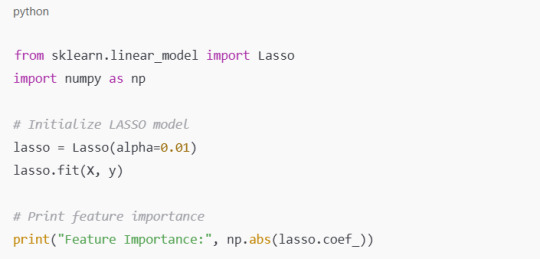
Tools:
Scikit-learn: Implements Lasso, RandomForestClassifier.feature_importances_.
XGBoost & LightGBM: Provide built-in feature importance functions.
2. Unsupervised Feature Selection
Unsupervised feature selection is used when the dataset lacks labels. It identifies intrinsic patterns within the data to remove redundant or irrelevant features.
Types of Unsupervised Feature Selection Methods
2.1 Variance Thresholding
This method removes features with low variance, assuming that low-variance features contribute less information.
Implementation Example (Python - Variance Threshold)

Tools:
Scikit-learn: Implements VarianceThreshold.
2.2 Feature Clustering
This method groups correlated features and selects a representative feature from each cluster.
Implementation Example (Python - Clustering Features)
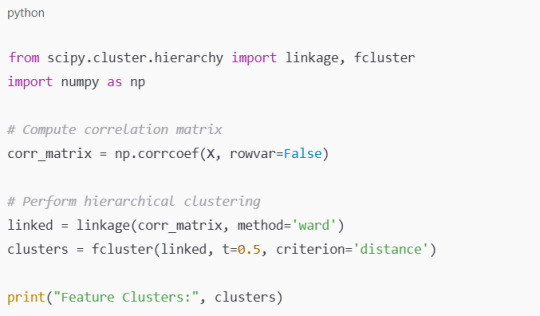
Tools:
SciPy: Provides clustering functions.
Scikit-learn: Implements AgglomerativeClustering for hierarchical clustering.
2.3 Principal Component Analysis (PCA)
PCA transforms correlated features into independent principal components, reducing dimensionality while preserving information.
Implementation Example (Python - PCA)
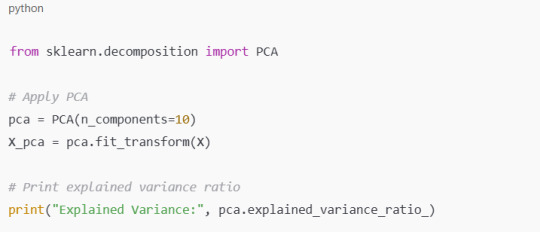
Tools:
Scikit-learn: Implements PCA.
Feature selection is key in machine learning workflows, improving efficiency, interpretability, and model accuracy. Supervised techniques are useful when labelled data is available, while unsupervised techniques help in unlabeled scenarios by identifying intrinsic patterns.
✔ Use filter methods when speed and scalability are priorities. ✔ Use wrapper methods when computational power allows for iterative selection. ✔ Use embedded methods when training models that naturally rank feature importance. ✔ Use unsupervised methods for dimensionality reduction in unlabeled datasets.
Evaluating Feature Selection Performance
Optimising model performance in machine learning requires effective feature selection to eliminate unnecessary and redundant features. However, removing features is insufficient; we must evaluate whether the process is beneficial. This requires assessing how feature selection affects model accuracy, training efficiency, and interpretability.
A well-executed feature selection process should: ✅ Improve model interpretability (by using fewer, more meaningful features) ✅ Reduce overfitting (by eliminating noisy or irrelevant features) ✅ Maintain or improve accuracy (ensuring the model generalises well) ✅ Improve training efficiency (by reducing computational complexity)
Key Evaluation Metrics for Feature Selection Performance
1. Model Performance Metrics (Before vs. After Feature Selection)
The effect of feature selection is assessed by evaluating the model’s performance before and after its application. The following classification and regression metrics help evaluate the improvement:
🔹 Classification Metrics:
Accuracy: Measures overall correctness of predictions.
Precision: Evaluate how many positive predictions were correct.
Recall: Measures the model’s success in identifying real positive outcomes.
F1-Score: Harmonic mean of precision and recall, useful for imbalanced datasets.
AUC-ROC Curve: Helps determine the separability of classes in a classification task.
🔹 Regression Metrics:
Mean Squared Error (MSE): Represents the mean squared deviation between observed and predicted outcomes.
R-squared (R²): Indicates how well the features explain variance in the target variable.
Mean Absolute Error (MAE): Captures the absolute differences between predicted and actual values.
2. Feature Importance Scores
Feature importance analysis helps identify which features contribute the most to model predictions. After feature selection, we compare the importance ranking of selected vs. removed features.
✅ Tree-based models (e.g., Random Forest, XGBoost) assign importance scores to features. ✅ SHAP values provide an explainable AI approach to feature importance. ✅ Lasso Regression (L1 regularisation) shrinks coefficients of less important features to zero.
Example: Visualizing Feature Importance in a Decision Tree Model
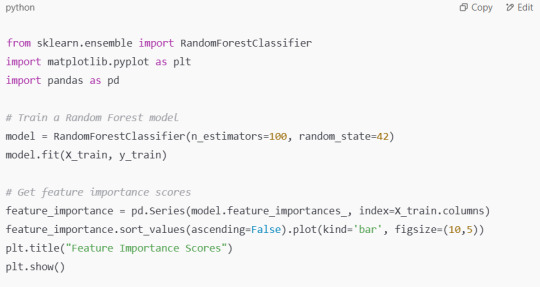
3. Training Time Improvement
Reducing the number of features often decreases training time and reduces computational costs. After feature selection, we compare: ✅ Model training time before and after feature selection. ✅ Inference speed (time taken to make predictions). ✅ Memory usage (especially for large datasets).
Example: Measuring Model Training Time
Python
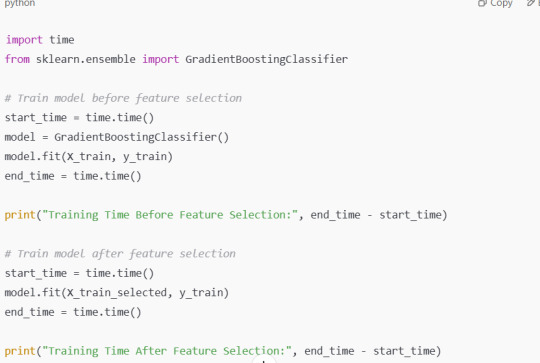
Step-by-Step Process to Evaluate Feature Selection Performance
Step 1: Train and Evaluate a Baseline Model (Before Feature Selection)
Split the data into distinct training and testing groups.
Train a machine learning model using all features.
Evaluate model performance using accuracy, precision, recall, or MSE.
Record feature importance scores and training time.
Step 2: Apply Feature Selection Techniques
Use filter, wrapper, or embedded methods to remove irrelevant features.
Select key features efficiently by leveraging statistical tests or model-driven feature ranking techniques.
Transform the dataset using selected features.
Step 3: Train and Evaluate the Model Again (After Feature Selection)
Train the model on the reduced feature set.
Measure model performance (accuracy, F1-score, MSE, R², etc.).
Compare feature importance rankings before and after selection.
Measure training time improvement and memory efficiency.
Step 4: Compare Results and Make Decisions
If model performance remains stable or improves, feature selection is successful.
If performance drops significantly, reconsider the feature selection method.
If training time and computational efficiency improve, the selected features are optimal.
Example: Full Workflow with Python Code
from sklearn.ensemble import RandomForestClassifier
from sklearn.feature_selection import SelectKBest, chi2
from sklearn.metrics import accuracy_score
import time
# Step 1: Train baseline model
model = RandomForestClassifier(n_estimators=100, random_state=42)
start_time = time.time()
model.fit(X_train, y_train)
y_pred = model.predict(X_test)
baseline_accuracy = accuracy_score(y_test, y_pred)
baseline_time = time.time() - start_time
print("Baseline Model Accuracy:", baseline_accuracy)
print("Baseline Training Time:", baseline_time)
# Step 2: Apply Feature Selection (Filter Method - Chi-Square)
selector = SelectKBest(score_func=chi2, k=10) # Select top 10 features
X_train_selected = selector.fit_transform(X_train, y_train)
X_test_selected = selector.transform(X_test)
# Step 3: Train Model After Feature Selection
start_time = time.time()
model.fit(X_train_selected, y_train)
y_pred_selected = model.predict(X_test_selected)
selected_accuracy = accuracy_score(y_test, y_pred_selected)
selected_time = time.time() - start_time
print("Accuracy After Feature Selection:", selected_accuracy)
print("Training Time After Feature Selection:", selected_time)
# Step 4: Compare Results
print("Accuracy Improvement:", selected_accuracy - baseline_accuracy)
print("Training Time Reduction:", baseline_time - selected_time)
Conclusion
Evaluating feature selection algorithms is key to ensuring optimal model performance, efficiency, and interpretability. We can eliminate redundant features, reduce overfitting, and improve generalisation by comparing techniques using accuracy, precision, recall, MSE, feature importance rankings, and computational efficiency. Feature selection is a crucial step in optimisation in machine learning, as it helps streamline models by reducing complexity while maintaining high predictive accuracy.
Different models respond uniquely to filter, wrapper, embedded, and advanced methods (e.g., SHAP, Boruta, Autoencoders), making it essential to test multiple approaches. Feature selection methods should be chosen considering the dataset size, the nature of the model, and system resource availability.
A well-executed feature selection process balances accuracy and efficiency, ensuring that only the most relevant features drive predictions. Ultimately, robust feature selection enhances model reliability, making machine-learning solutions more scalable and effective in real-world applications.
0 notes
Text
data science course
ExcelR’s data science course offers online, offline, and hybrid learning options to fit your schedule. Learn quickly, gain industry-relevant skills, and open doors to exciting career opportunities—all from your hometown! Enrol now.
Business Name: ExcelR - Data Science, Data Analytics Course Training in Pune
Address: 101 A ,1st Floor, Siddh Icon, Baner Rd, opposite Lane To Royal Enfield Showroom, beside Asian Box Restaurant, Baner, Pune, Maharashtra 411045
Phone Number: 098809 13504
Email : [email protected]
0 notes
Text
Artificial Intelligence Course
ExcelR’s AI course offers hands-on training in machine learning, deep learning, and NLP. Master Python, TensorFlow, and AI frameworks through real-world projects. Learn from industry experts and build AI-driven solutions for career growth in data science. Elevate your skills with practical insights. Enroll now!
0 notes
Text
Optimization in Machine Learning
ExcelR's Data Science Course provides in-depth training in data analysis, machine learning, and AI. A key module, Optimization in Machine Learning, covers techniques like gradient descent, hyperparameter tuning, and loss function minimization to improve model accuracy. With hands-on projects and industry-aligned content, this course prepares professionals for a successful career in data science.
0 notes
Text
data science course in pune
Top-notch data science course in pune designed to equip students with in-demand skills like Python, R, SQL, and advanced analytics. With industry-focused training, live projects, and experienced instructors, learners gain hands-on experience and job-ready expertise. Flexible schedules and placement assistance make it a preferred choice for aspiring data professionals.
0 notes
Text
data science course in Mumbai
Top-notch data science course in mumbai designed to equip students with in-demand skills like Python, R, SQL, and advanced analytics. With industry-focused training, live projects, and experienced instructors, learners gain hands-on experience and job-ready expertise. Flexible schedules and placement assistance make it a preferred choice for aspiring data professionals.
data science course
0 notes
Text
Transform your career prospects with our data analyst course in mumbai, tailored for aspiring data professionals. Our supportive learning environment ensures you gain the skills and confidence needed to succeed. Get in touch with ExcelR now!
0 notes
Text
data analyst course
Develop essential data skills and stay competitive in the tech industry. ExcelR’s data analyst course prepares you for opportunities in top companies nationwide. Enroll with us now!
0 notes
Text
Top Data Science Skills Employers Look for in 2024
The field of data science continues to dominate the job market in 2024, with organisations across industries actively seeking skilled professionals who can extract actionable insights from data. However, with an increasing number of candidates entering the field, standing out requires more than just a degree or certification. Employers keep a lookout for specific skills that signify a data scientist’s ability to deliver results. Whether you're a budding data scientist or looking to upgrade your expertise, enrolling in a data science course can be a game-changer. If you're located in Maharashtra, data science courses in Pune are an excellent option for getting started.
Here’s a comprehensive guide to the top data science skills employers are prioritising in 2024:
1. Proficiency in Programming Languages
Data scientists must possess strong programming skills to work efficiently with data. The two most sought-after languages are Python and R, known for their extensive libraries and frameworks designed for data manipulation, statistical analysis, and machine learning. Employers value candidates who can write clean, optimised code for tasks ranging from data preprocessing to deploying machine learning models.
If you're just starting out, look for data science courses that provide hands-on training in these languages. For instance, courses in Pune offer extensive programming modules tailored to industry requirements.
2. Strong Foundations in Statistics and Mathematics
Understanding statistical methods and mathematical concepts is the backbone of data science. Employers expect candidates to be proficient in areas such as:
Probability distributions
Hypothesis testing
Linear algebra
Optimisation techniques
These skills enable data scientists to interpret data accurately and develop reliable predictive models. A good data science course in Pune often includes in-depth modules on these concepts, ensuring you build a solid foundation.
3. Data Wrangling and Cleaning
Raw data is rarely clean or structured. Companies need professionals who can preprocess data effectively to make it usable. Skills in data wrangling—including dealing with missing values, outliers, and inconsistent formats—are critical.
Tools like Pandas and NumPy in Python are essential for this task. If you're looking to master these tools, enrolling in comprehensive data science courses can help you gain the expertise required to handle messy datasets.
4. Expertise in Machine Learning Algorithms
Machine learning (ML) remains at the heart of data science. Employers look for candidates familiar with both supervised and unsupervised learning algorithms, such as:
Regression models
Decision trees
Random forests
Clustering methods
Neural networks
Being able to implement and fine-tune these algorithms is vital for solving real-world problems. Many data science courses in Pune offer practical projects that simulate industry scenarios, helping you gain hands-on experience with ML models.
5. Data Visualisation and Storytelling
Conveying insights to stakeholders is as important as deriving them. Employers seek candidates skilled in data visualisation tools like:
Tableau
Power BI
Matplotlib and Seaborn
The ability to craft compelling visual narratives ensures that decision-makers understand and trust your insights. Opt for a data science course that includes modules on data storytelling to strengthen this crucial skill.
6. Knowledge of Big Data Tools
In 2024, businesses deal with massive volumes of data. Handling such data efficiently requires expertise in big data technologies like:
Apache Hadoop
Apache Spark
Hive
These tools are highly valued by organisations working on large-scale data processing. A specialised data science course in Pune often integrates these tools into its curriculum to prepare you for big data challenges.
7. Cloud Computing Skills
With most companies transitioning to cloud-based infrastructure, data scientists are expected to have a working knowledge of platforms like AWS, Azure, and Google Cloud. Skills in deploying data pipelines and machine learning models on the cloud are particularly in demand.
Some advanced data science course in pune offer cloud computing modules to help professionals gain a competitive edge.
8. Business Acumen
Employers favor data scientists who understand the business domain they operate in. This skill helps align data science efforts with organisational goals. Whether you're working in finance, healthcare, or retail, the ability to contextualise data insights for business impact is invaluable.
Courses in cities like Pune often include case studies and projects that simulate real-world business challenges, enabling students to develop industry-relevant expertise.
9. Soft Skills: Communication and Team Collaboration
Data science is not a solo endeavour. Employers prioritise candidates who can communicate their findings effectively and collaborate with cross-functional teams. Strong presentation skills and a knack for simplifying technical concepts for non-technical audiences are essential.
10. Continuous Learning Mindset
The rapidly evolving nature of data science means professionals must stay updated on new tools, frameworks, and methodologies. Employers value individuals who show a commitment to learning, making ongoing professional development crucial.

Conclusion
The demand for professionals in data science will only grow in the coming years, but standing out in this competitive field requires mastering a mix of technical and non-technical skills. Whether it’s honing your programming capabilities, diving into machine learning, or building your storytelling prowess, each skill enhances your employability.
For aspiring data scientists, taking part in a data science education tailored to industry demands is the first step. If you’re in Maharashtra, consider enrolling in data science courses in Pune, where you can access high-quality training and networking opportunities in the city’s thriving tech ecosystem.
By investing in your skill set today, you can position yourself as a top candidate in the ever-evolving data science job market.
Business Name: ExcelR - Data Science, Data Analytics Course Training in Pune
Address: 101 A ,1st Floor, Siddh Icon, Baner Rd, opposite Lane To Royal Enfield Showroom, beside Asian Box Restaurant, Baner, Pune, Maharashtra 411045
Phone Number: 098809 13504
Email : [email protected]
0 notes